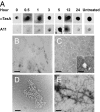Amyloid fibers provide structural integrity to Bacillus subtilis biofilms
- PMID: 20080671
- PMCID: PMC2836674
- DOI: 10.1073/pnas.0910560107
Amyloid fibers provide structural integrity to Bacillus subtilis biofilms
Abstract
Bacillus subtilis forms biofilms whose constituent cells are held together by an extracellular matrix. Previous studies have shown that the protein TasA and an exopolysaccharide are the main components of the matrix. Given the importance of TasA in biofilm formation, we characterized the physicochemical properties of this protein. We report that purified TasA forms fibers of variable length and 10-15 nm in width. Biochemical analyses, in combination with the use of specific dyes and microscopic analyses, indicate that TasA forms amyloid fibers. Consistent with this hypothesis, TasA fibers required harsh treatments (e.g., formic acid) to be depolymerized. When added to a culture of a tasA mutant, purified TasA restored wild-type biofilm morphology, indicating that the purified protein retained biological activity. We propose that TasA forms amyloid fibers that bind cells together in the biofilm.
Conflict of interest statement
The authors declare no conflict of interest.
Figures






References
-
- O’Toole G, Kaplan HB, Kolter R. Biofilm formation as microbial development. Annu Rev Microbiol. 2000;54:49–79. - PubMed
-
- Branda SS, Vik S, Friedman L, Kolter R. Biofilms: The matrix revisited. Trends Microbiol. 2005;13:20–26. - PubMed
-
- Klemm P, Schembri MA. Bacterial adhesins: Function and structure. Int J Med Microbiol. 2000;290:27–35. - PubMed
-
- Lasa I, Penadés JR. Bap: A family of surface proteins involved in biofilm formation. Res Microbiol. 2006;157:99–107. - PubMed
Publication types
MeSH terms
Substances
Grants and funding
LinkOut - more resources
Full Text Sources
Other Literature Sources
Molecular Biology Databases

